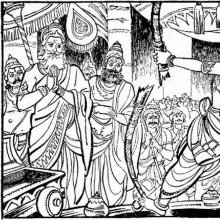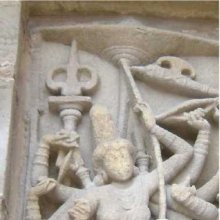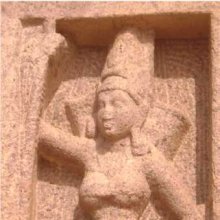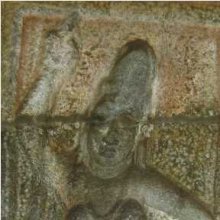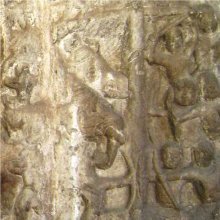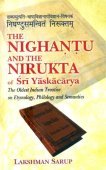Bow: 2 definitions
Introduction:
Bow means something in Hinduism, Sanskrit, the history of ancient India. If you want to know the exact meaning, history, etymology or English translation of this term then check out the descriptions on this page. Add your comment or reference to a book if you want to contribute to this summary article.
Images (photo gallery)
(+91 more images available)
In Hinduism
Shilpashastra (iconography)
Source: Shodhganga: Elements of Art and Architecture in the Trtiyakhanda of the Visnudharmottarapurana (shilpa)The Bow is denoted by the Sanskrit term Cāpa, and represents one of the five kinds of Eyes, which follows specific guidelines of ancient Indian Painting (citra), according to the Viṣṇudharmottarapurāṇa, an ancient Sanskrit text which (being encyclopedic in nature) deals with a variety of cultural topics such as arts, architecture, music, grammar and astronomy.—In the Viṣṇudharmottarapurāṇa also, different kinds of eyes and their particular shapes are elaborately discussed in the context of Painting. According to the Viṣṇudharmottarapurāṇa, the first variety of the eye should be in the shape of cāpa i.e., a bow and it should be three yavas in measurement

Shilpashastra (शिल्पशास्त्र, śilpaśāstra) represents the ancient Indian science (shastra) of creative arts (shilpa) such as sculpture, iconography and painting. Closely related to Vastushastra (architecture), they often share the same literature.
India history and geography
Source: Singhi Jain Series: Ratnaprabha-suri’s Kuvalayamala-katha (history)Bows (as a weapon) were commonly depicted on the Saṃsāracakra paintings (representing scenes of human life), in ancient India, as mentioned in the Kathās (narrative poems) such as Uddyotanasūri in his 8th-century Kuvalayamālā (a Prakrit Campū, similar to Kāvya poetry).—Page 185.21 f.: Here follows a description of a printed scroll illustrating the Jaina conception of saṃsāracakra. [...] The saṃsāra-cakra illustrated the three worlds of hell, human world and the world of gods. [For example:] Persons shooting animals with bow and arrow; a person holding a naked sword and showing feats of swordsmanship; parrots and magpies put in cages for amusement

The history of India traces the identification of countries, villages, towns and other regions of India, as well as mythology, zoology, royal dynasties, rulers, tribes, local festivities and traditions and regional languages. Ancient India enjoyed religious freedom and encourages the path of Dharma, a concept common to Buddhism, Hinduism, and Jainism.
See also (Relevant definitions)
Starts with: Bow and arrow, Bow-wood, Bowal gach, Bowal goch, Bowal-gach, Bowing, Bowirdi, Bowl of liquid, Bowley sage, Bowlisangu, Bowltube iris, Bowrveil, Bowstring-hemp, Bowtamaka.
Full-text (+2961): Dhanus, Capa, Sharnga, Gandiva, Kodanda, Karmuka, Dhanu, Pinaka, Dhanushka, Ajagava, Dhanurdhara, Atani, Vishphara, Lastaka, Tankara, Jya, Dhanvin, Dhanushkara, Tihan, Dhanva.
Relevant text
Search found 312 books and stories containing Bow; (plurals include: Bows). You can also click to the full overview containing English textual excerpts. Below are direct links for the most relevant articles:
The Devi Bhagavata Purana (by Swami Vijñanananda)
Chapter 9 - On the fight between the Riṣis and Prahlāda < [Book 4]
Chapter 13 - On the killing of Vāskala and Durmukha < [Book 5]
Chapter 28 - On the incidents connected with Navarātri < [Book 3]
Harshacharita (socio-cultural Study) (by Mrs. Nandita Sarmah)
Part 9.4: Weapons of the War < [Chapter 5 - Political Aspects]
1. Similarities (3): Education System < [Chapter 8 - Comparative Society as described in the Kādambarī and the Harṣacarita]
Part 3: Description of Different Tribes and Sub-Castes < [Chapter 2 - Caste System]
Trishashti Shalaka Purusha Caritra (by Helen M. Johnson)
Part 8: Future Cakrins < [Chapter VI]
Part 14: Contest for Sītā < [Chapter IV - The, birth, marriage, and retreat to the forest of Rāma and Lakṣmaṇa]
Part 4: Birth of Ānanda < [Chapter III - Ānandapuruṣapuṇḍarīkabalicaritra]
Harivamsha Purana (by Manmatha Nath Dutt)
Chapter 27 - Krishna’s Arrival < [Book 2 - Vishnu Parva]
Chapter 34 - The Mountains Set Asuras Fighting with the Gods < [Book 3 - Bhavishya Parva]
Chapter 35 - Jarasandha’s Army < [Book 2 - Vishnu Parva]
Tiruvaymoli (Thiruvaimozhi): English translation (by S. Satyamurthi Ayyangar)
Pasuram 7.7.4 < [Section 7 - Seventh Tiruvaymoli (Elaiyar avo)]
Pasuram 6.6.1 < [Section 6 - Sixth Tiruvaymoli (Malukku, vaiyam alanta)]
Pasuram 7.7.8 < [Section 7 - Seventh Tiruvaymoli (Elaiyar avo)]
Ramayana (by Manmatha Nath Dutt)
Chapter LXVII < [Book 1 - Bāla-kāṇḍa]
Chapter LXXV < [Book 1 - Bāla-kāṇḍa]
Chapter LXVI < [Book 1 - Bāla-kāṇḍa]
Related products
